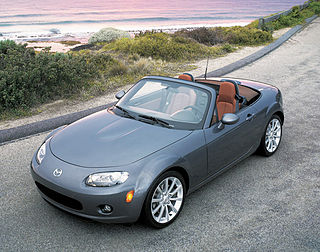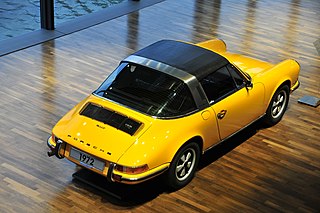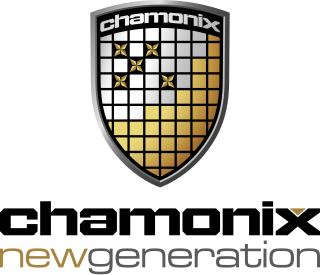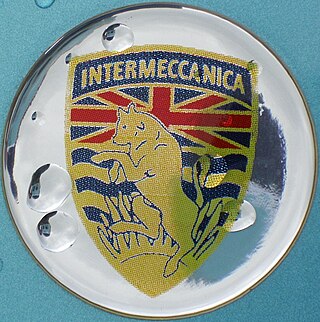
The Porsche 356 is a sports car that was first produced by Austrian company Porsche Konstruktionen GesmbH (1948–1949), and then by German company Dr. Ing. h. c. F. Porsche GmbH (1950–1965). It was Porsche's first production automobile. Earlier cars designed by the Austrian company include Cisitalia Grand Prix race car, the Volkswagen Beetle, and Auto Union Grand Prix cars.

A kit car is an automobile available as a set of parts that a manufacturer sells and the buyer then assembles into a functioning car. Usually, many of the major mechanical systems such as the engine and transmission are sourced from donor vehicles or purchased new from other vendors. Kits vary in completeness, consisting of as little as a book of plans, or as much as a complete set with all components to assemble into a fully operational vehicle such as those from Caterham.

A convertible or cabriolet is a passenger car that can be driven with or without a roof in place. The methods of retracting and storing the roof vary across eras and manufacturers.
Wilhelm Karmann GmbH, commonly known as Karmann, was a German automobile manufacturer and contract manufacturer based in Osnabrück, Germany. Founded by Wilhelm Karmann in 1901, the company specialised in various automotive roles, including design, production and assembly of components for a wide variety of automobile manufacturers, including Chrysler, Porsche, Mercedes-Benz and Volkswagen Group.

Targa top, or targa for short, is a semi-convertible car body style with a removable roof section and a full-width roll bar behind the seats. The term was first used on the 1966 Porsche 911 Targa, and it remains a registered trademark of Porsche AG.

The Jaguar XJ-S is a luxury grand tourer manufactured and marketed by British car manufacturer Jaguar Cars from 1975 to 1996, in coupé, fixed-profile and full convertible bodystyles. There were three distinct iterations, with a final production total of 115,413 units over 20 years and seven months.

The Geneva International Motor Show was an annual auto show held in March in the Swiss city of Geneva.

The International Motor Show Germany or International Mobility Show Germany, in German known as the Internationale Automobil-Ausstellung, is one of the world's largest mobility trade fairs. It consists of two separate fairs, that subdivided in 1991. While the IAA Mobility displays passenger vehicles, motorcycles and bikes, the IAA Transportation specializes in commercial vehicles. Before the separation, the show was held solely at the Messe Frankfurt.

Chamonix NG Cars is a Brazilian automobile manufacturer based in São Paulo. Until about 2011 it was known as Chamonix Indústria e Comércio and located in Jarinu (SP). The "NG" in the company name stands for New Generation. The company was founded in 1981 by Milton Masteguin, formerly with Puma Cars as constructor of racing vehicles, and the US-American automotive engineer Chuck Beck.

The Los Angeles Auto Show, also known as the LA Auto Show, is an auto show held annually at the Los Angeles Convention Center in Los Angeles, California, United States. It is open to the public for ten days, filling 760,000 square feet (71,000 m2) of exhibit space. Since 2006 the event is held in November or December.

GTM Cars was a component kit car manufacturer located in Kingswinford, UK.

Intermeccanica is an automobile manufacturer, founded in Torino, Italy, in 1959 by Frank Reisner and Paula Reisner. It subsequently moved first to the United States, then to Canada, and is currently headed by Frank's son, Henry Reisner.

The 2010 Paris Motor Show took place from 2 October to 17 October 2010, in Paris expo Porte de Versailles.

Driven to Distraction is a non-fiction book, first published in 2009, written by English journalist and television presenter Jeremy Clarkson. The book is a collection of Clarkson's articles for the Sunday Times newspaper, all originally published in 2006 and 2007. The articles consist of car reviews combined with rants on current events.

The Velo Rossa is a fibre reinforced plastic composite automobile body built by Reaction Research in Scottsdale, Arizona, USA. It is designed to re-style the body of the 1970-1978 Datsun/Nissan S30 Z series cars. Front end appearance panels are replaced. Doors and rear external components are over-skinned after trimming out the wheel wells for wider tires.

New Zealand had a long history of small garages and vehicle enthusiasts modifying and creating sports and sports racing cars. Out of these interests grew the New Zealand kit and replica car industry with the introduction of fibre-glass car bodies in the 1950s.

Karosserie Friedrich Rometsch, a German metallurgical-coachbuilding company based in Berlin-Halensee, Nestorstrasse 41, manufactured, modified, and repaired coaches, trailers, bodies and chassis.

Jaguar R and R-S/SVR models are a range of high performance versions of certain car models from the British automotive marque Jaguar Cars, part of parent business Jaguar Land Rover. These cars primarily focus on enhanced "sport" performance. Jaguar began producing R models in 1988 with the introduction of the first XJR, and began producing R-S models in limited production numbers and input from Jaguar SVO (Special Vehicle Operations) with the introduction of the 2012 XKR-S. The R-S mark has since been replaced by the SVR (Special Vehicle Racing) designation, which was first introduced on the 2017 Jaguar F-Type SVR, effectively making the XFR-S the last Jaguar SVO car not to carry the SVR moniker.
Carrosserie + Spritzwerk Beutler AG, previously Gebr. Beutler & Cie. and Carrosserie Beutler AG was a Swiss coachbuilder that manufactured handcrafted bodies on passenger car chassis.

















